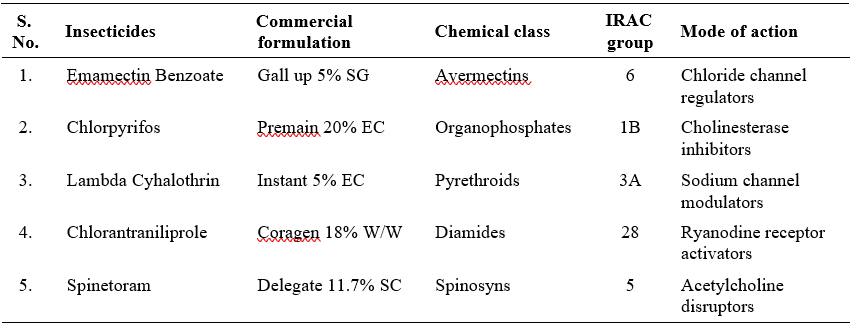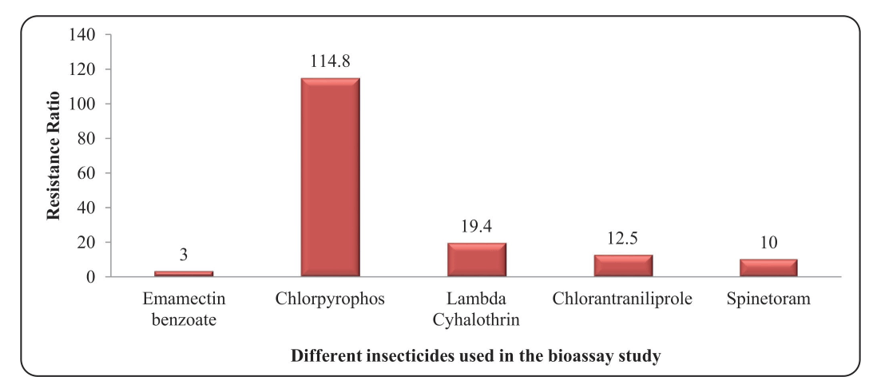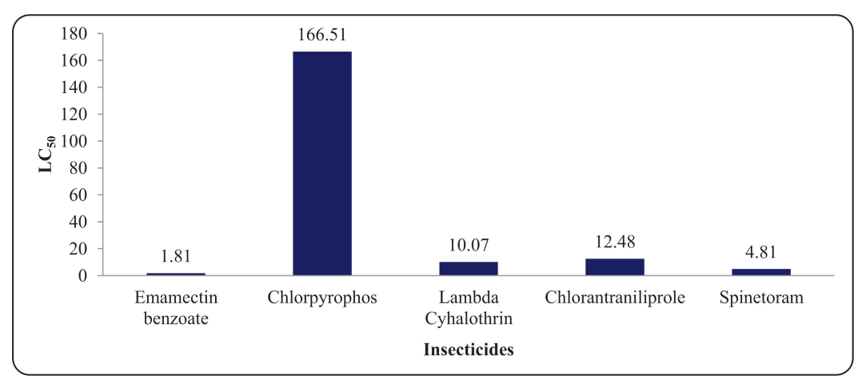Insecticide Resistance Monitoring of Fall Armyworm (Spodoptera Frugiperda j.e. Smith) In Chittoor District of Andhra Pradesh
0 Views
N. JASHWANTH KUMAR*, RAJASRI MANDALI, K. DEVAKI AND M. GURIVI REDDY
Department of Entomology, S.V. Agricultural College, ANGRAU, Tirupati-517502.
ABSTRACT
Maize (Zea mays L.) is considered as queen of the cereals and is one of the most important crop next to rice and wheat
in global agriculture. It has very high yield potential and there is no such cereal crop on the earth which has such immense potentiality. Globally it is highly valued for its multiple uses such as food, feed, fodder and raw material for large number of industrial products. Fall armyworm (FAW), Spodoptera frugiperda (J.E. Smith) is a dangerous transboundary pest, can cause significant yield losses if it is not managed well in time. Hence bioassay studies were conducted on third instar FAW larvae from F1 population of field collections from chittoor of Andhra Pradesh using diet incorporation assay (IRAC test method) to check the resistance monitoring. The studies on the resistance levels in S. frugiperda to five insecticides viz., emamectin benzoate, chlorpyriphos, lambda-cyhalothrin, chlorantraniliprole and spinetoram. revealed the high level of resistance to conventional insecticides like chlorpyrifos (114.8 folds), lambda cyhalothrin (19.4 folds), and low level of resistance to new chemicals like chlorantraniliprole (12.5 folds), spinetoram (10 folds) and emamectin benzoate (3 folds).
KEYWORDS: Fall armyworm, Resistance monitoring, Resistance level.
INTRODUCTION
Maize (Zea mays L.) is considered as queen of the cereals and is one of the most important crop next to rice and wheat in global agriculture . It has very high yield potential and there is no cereal on the earth which has so immense potentiality. Globally it is highly valued for its multiple uses such as food, feed, fodder and raw material for large number of industrial products.
Fall armyworm (FAW), Spodoptera frugiperda (J.E. Smith) is a dangerous transboundary pest, able to fly over 100 km in one single night (Naganna et al., 2020) with a high potential to spread continually because of natural distributional capacity and international trade. FAW can cause significant yield losses if it is not managed well in time. S. frugiperda has recently become the new invasive species in both the West and Central Africa where the outbreaks have been recorded for the very first time in early 2016 (Georgen et al., 2016). In India it was first reported in Karnataka during May 2018 (Sharanabasappa et al., 2018). This rapid spread and difficulty in controlling S. frugiperda is due to its high migration ability, high reproductive capacity, absence of diapause, wider host range, suitable tropical climate as well as polyphagous nature.
The development of the dose mortality responses for the insecticides is necessary to provide baseline data for a future resistance monitoring studies for polyphagous pests like S. frugiperda. These invaded FAW populations attacked the maize crop in different South Indian states and also different districts of Andhra Pradesh and to control these voracious feeders, farmers spray different groups of pesticides indiscriminately without any label claim. These invaded FAW population which travelled across continents may be exposed to different groups of pesticides and may have some innate capability to tolerate the insecticides. But there is no baseline toxicity data available for this S. frugiperda larvae to different insecticides. Therefore, this study on insecticide resistance monitoring of fall armyworm in Chittoor district of Andhra Pradesh is carried out.
MATERIAL AND METHODS
Collection of field population fall armyworm
Roving survey was conducted Chittoor district of Andhra Pradesh during rabi, 2021-2022 to know the severity of incidence of Fall armyworm (FAW) on maize and collected the larval populations from three mandals during the survey period to study the resistance monitoring studies among the collected larval population.
Fifty larvae were collected from each mandal and kept individually in plastic cups and brought to the laboratory for further studies.
Mass multiplication of FAW, S. frugiperda
The collected larvae from Chittoor districts were separately reared on artificial diet (Barreto et al., 1999) till pupation. Then the pupae were collected and kept in Acrylic rearing chambers of dimensions 26.5 cm × 29.5 cm × 29.5 cm for adult emergence. The cotton swabs dipped in 40 per cent honey solution were arranged as food for emerging adults and Maize seedlings of 5 to 7 days old were kept inside the rearing chambers for egg laying by S. frugiperda adults.
The rearing chambers were checked regularly for replacement of honey solution and egg laying by adult moths of FAW. The egg masses were collected and transferred to plastic troughs and allowed for hatching. After hatching the neonates were allowed to feed on fresh sweet corn kernels until they reach third instar and then transferred to artificial diet boxes for individual feeding to avoid cannibalism.
Preparation of stock solutions
Stock solutions of test insecticides were prepared by using the formula (Naveed, 2005) (Table 2).
Stock solution =

Stock solution of 100 mL was used for the preparation of desired concentration by serial dilution method. Untreated control was also maintained for each insecticide tested and the mortality data was corrected by using modified Abbotts formula (Abbott, 1925) wherever
>10% mortality recorded in the untreated control.
Abbott’s formula for corrected mortality =

T = Mortality in treatment
C = Mortality in control
Bioassay studies with Fall armyworm, S. frugiperda
For conducting Bioassay, artificial diet incorporation method was used (IRAC Method, 2020). The stock solution of the insecticides was prepared in 100 ml of distilled water and subsequently, 1 ml of insecticide solution was mixed with 9 ml of diet and allowed to solidify. Then third instar larvae were selected and pre starved separately for 4 hours, then placed into large cell wells containing a cube of the insecticide infused diet. A control diet was maintained without mixing any insecticide. Each treatment was replicated thrice.
Statistical analysis
The larval mortality counts were taken at 24, 48 and 72 hours after treatment. The larvae which did not show any movement and moribund were treated as dead. Data on mortality was subjected to probit analysis (Finney, 1971). LC50 and LC90 values were calculated using SPSS statistical package.
Assessment of insecticidal resistance in S. frugiperda
The degree of development of resistance through different generations was determined by working out LC50 values in next generation and thus computing the resistance ratio (RR) by dividing the LC50 value of field population with LC50 value of the baseline susceptible population (Tabashnik et al., 1987).
Resistance ratio =

RESULTS
The results of the survey indicate that higher incidence of fall armyworm was observed in Tirupati rural (63.81%) followed by Chandragiri (62.55%) and byreddipalli (50.46%) (Table 1). The farmers of chittoor district are not much aware of the latest chemicals and mostly they are using the conventional insecticides like neem formulations, chlorpyriphos, profenophos, cypermethrin etc., which are not so effective against FAW in maize The LC50 values of different insecticides are Chlorpyriphos, 166.51 μg/ml > chlorantraniliprole, 12.48 μg/ml > lambda cyhalothrin, 10.07 μg/ml > Spintoram,
Table 1. List of mandals and villages of Chittoor district of Andhra Pradesh surveyed for the incidence of FAW on maize during rabi, 2021-2022

4.81 μg/ml > emamectin benzoate, 1.81 μg/ml. (Table 3 and Fig. 2)
Among the different insecticides used the relative resistance ratios was higher for chlorpryiphos (114.8) followed by lambdacyhalothrin (19.4), chlorantraniliprole (12.8), spinetoram (10) and emamectin benzoate (3) (Table 3 and fig. 1). The differences in the levels of resistance of FAW populations may be due to increased spraying frequencies of new chemicals like emamectin benzoate, chlorantraniloprole and spinetoram in maize ecosystem to manage the FAW even at an early vegetative stage till tasselling stage.
The resistance ratios of emamectin benzoate were in accordance with Grace et al. (2019) who studied the resistance of S. litura from Kurnool district during 2016-2017. The resistance ratios of Lambda cyhalothrin, chlorantraniliprole and cyantraniliprole were in accordance with Zhang et al. (2021) who studied the resistance of S. frugiperda from different populations of China during 2019. These findings are in collaboration with Song et al. (2020) who reported that the spraying frequency of ememectin benzoate increased to 6.83 times during 2019 in west Yunnan since FAW invaded china.
These results are in line with the reports of Zhang et al. (2021) who reported the insecticide resistance in FAW from China to different insecticides like 615-1068 folds to chlorpyriphos, 60-388 folds to spinosad, 26-317 folds to lambda cyhalothrin, 13-29 folds malathion, 3-8 folds to emamectin benzoate and 1-2 folds to chlorantraniliprole, respectively.
Insecticide resistance to FAW has been reported from different American, African and Asian countries which created havoc in maize cultivation and resulted in crop failures, food and nutritional security. The indiscriminate use of insecticide resulted in development of resistance to organophosphate and synthetic pyrethroids in Puerto- Rico (Gutierro-Moreno et al., 2019), lambda cyhalothrin, chlorpyriphios (Carvalho et al., 2013), lufenuron (Nascimento et al., 2016) and spinosad (Okuma et al., 2018).
Table 2. Insecticides used for bioassay studies against Fall armyworm, S. frugiperda

Table 3. The resistance level of fall armyworm, S. frugiperda populations collected from Chittoor district of Andhra Pradesh against different insecticides at 72 HAT during rabi, 2021-2022

- The baseline LC50 values to emamectin benzoate of susceptible strain was taken from Gutierrez-Moreno et al. (2018)
- The base line LC50 values to chloryriphos of susceptible strain was taken from Yu (1991)
- The base line LC50 values to chloryriphos of susceptible strain was taken from Yu (1991)
- The baseline LC50 values to chlorantraniliprole of susceptible strain was taken from Gutierrez-Moreno et al. (2018)
- The baseline LC50 values to spinetoram of susceptible strain was taken from Zhao et al. (2020)

Fig. 1. Relative resistance of fall armyworm, S. frugiperda to different insecticides in Chittoor district.

Fig. 2. LC50 values of different insecticides used against FAW from Chittoor district.
Fall armyworm, recently introduced transboundary pest into India exhibited insecticide resistance to test insecticides belongs to different groups. This is the first report of resistance development in S. frugiperda populations from Andhra Pradesh. The data generated in this study on susceptibility of FAW to different insecticides can be used as a baseline for future IRM studies on S. frugiperda populations in Andhra Pradesh. Even though fall armyworm is a new invasive pest it is showing higher level of resistance to different class of insecticides indicating the increased resistance to different class of insecticides.
LITERATURE CITED
Abbott, W.S. 1925. A method of computing the effectiveness of an insecticide. Journal of Economic Entomology. 18(2): 265-267.
Barreto, M.R., Loguerico, L.L., Valicente, F.H and Paiva, 1999. Insecticidal activity of culture Supernants from Bacillus thuringiensis Berliner strains against Spodoptera frugiperda Smith (Lepidoptera: Noctuidae) larvae. Proceedings of the Entomological Society of Brazil. 28(4): 675-685.
Carvalho, R. A., Omoto, C., Field, L. M., Williamson, S and Bass, C. 2013. Investigating the Molecular Mechanisms of Organophosphate and Pyrethroid Resistance in the Fall Armyworm Spodoptera frugiperda. PLoS ONE. 8(4): 1-11.
Finney, D.J. 1971. Probit analysis. 3rd Edition. S. chand and Co. Ltd., New Delhi. 333.
Goergen, G., Kumar, P.L., Sankung, S.B., Togola, A and Tamò, M. 2016. First report of outbreaks of the fall armyworm, Spodoptera frugiperda (J E Smith) (Lepidoptera, Noctuidae), a new alien invasive pest in West and Central Africa. Plos One. 11(10): 1-9.
Grace, A.D.G., Prasadarao, G.M.V., Krishnayya, P.V., Manoj, V and Srinivasarao, V. 2019. Monitoring of resistance in Spodoptera litura (fabricius) (Noctuidae: Lepidoptera) of Kurnool district of Andhra Pradesh to diamide group of insecticides. Journal of Pharmacognosy and Phytochemistry. 8(6): 299-303.
Gutierrez-Moreno, R., David, M., Carlos, A.B., Mark, E.W., Henry, T., Concepcion, R and Christiana, D. 2018. Field-Evolved resistance of fall armyworm (Lepidoptera: Noctuidae) to synthetic insecticides in Puerto Rice and Mexico. Journal of Economic Entomology. 112(2): 792-802.
Naganna, R., Jethva, D.M., Bhut, J.B., Pankaj, S.W and Akash, K. 2020. Present status of new invasive pest fall armyworm, Spodoptera frugiperda in India: A Review. Journal of Entomology and Zoology Studies. 8(2): 150-156.
Nascimento, A.B., Farias, J.R., Bernardi, D., Horikoshi,
R.J and Omoto, C. 2016. Genetic basis of Spodoptera frugiperda (Lepidoptera: Noctuidae) resistance to the chitin synthesis inhibitor lufenuron. Pest Management Science. 72(4): 810–815.
Naveed,M.R.2005.InsecticideResistanceinDiamondback moth Plutella xylostella (L.) (Lepidoptera: Plutellidae) and strategies of its management. Ph.D Thesis submitted to the Department of Entomology, Faculty of Crop and Food Sciences, University of Arid Agriculture, Rawlpindi, Pakistan.
Okuma, D.M., Bernardi, D., Horikoshi, R.J., Bernardi, O., Silva, A.P and Omoto, C. 2018. Inheritance and fitness costs of Spodoptera frugiperda (Lepidoptera: Noctuidae) resistance to spinosad in Brazil. Pest Management Science. 74(6):1441-1448.
Sharanabasappa., Kalleshwaraswamy, C. M., Asokan, R., Mahadevaswamy, H. M., Maruthi, M. S., Pavithro, H.B., Hegde, K., Navi, S., Prabhu, S.T and Goergin. 2018. First report of fall army worm, Spodoptera frugiperda (J.E. Smith) (Lepidoptera: Noctuidae) an alien invasive pest on maize in India. Pest Management in Horticultural Ecosystems. 24(1): 23-29.
Song, X.P., Liang, Y.J., Zhang, X.Q., Qin, Z.Q., Wei, J.J., Li, Y.R and Wu, J.M. 2020. Intrusion of Fall Armyworm (Spodoptera frugiperda) in Sugarcane and Its Control by Drone in China. Sugar Tech. 22: 734–737.
Tabashnik, B.E., Cushing, N.L and Johnson, M.W. 1987. Diamondback moth (Lepidoptera: Plutellidae) resistance to insecticides in Hawaii: intra-island variation and cross resistance. Journal of Economic Entomology. 80(6): 1091- 1099.
Test Methods | Insecticide Resistance Action Commiee (IRAC). Available online: https://irac-online.org/ methods/ (2020). Yu, S.J., 1991. Insecticide resistance in fall armyworm,
frugiperda (J.E.Smith). Pesticide Biochemistry and Physiology. 39: 84-91.
Zhang. D., Yu-tao, X., Peng-jun, X., Xian-ming, Y., Qiu-lin, W and Ming, W.K. 2021. Insecticide resistance monitoring for the Invasive populations of Fall armyworm, Spodoptera frugiperda in China. Journal of Integrative Agriculture. 783–791.
Zhao, Y., Huang, J., Ni, H., Guo, D., Yang, F., Wang, X., Wu, S and Gao, C. 2020. Susceptibility of fall armyworm, Spodoptera frugiperda (J.E. Smith), to eight insecticides in China, with special reference to lambda-cyhalothrin. Pesticide Biochemistry and Physiology. 8(3): 1-30.
- Bio-Formulations for Plant Growth-Promoting Streptomyces SP.
- Brand Preference of Farmers for Maize Seed
- Issues That Consumer Experience Towards Online Food Delivery (Ofd) Services in Tirupati City
- Influence of High Density Planting on Yield Parameters of Super Early and Mid Early Varieties of Redgram (Cajanus Cajan (L.) Millsp.)
- Influence of Iron, Zinc and Supplemental N P K on Yield and Yield Attributes of Dry Direct Sown Rice
- Effect of Soil and Foliar Application of Nutrients on the Performance of Bold Seeded Groundnut (Arachis Hypogaea L.)

